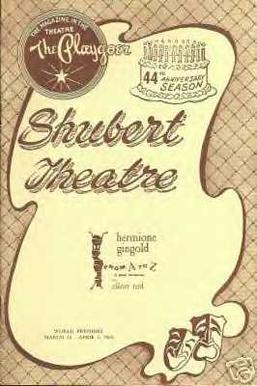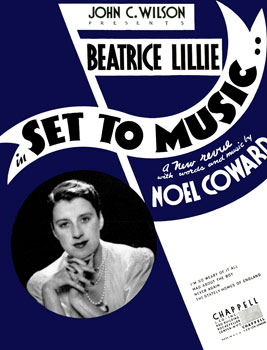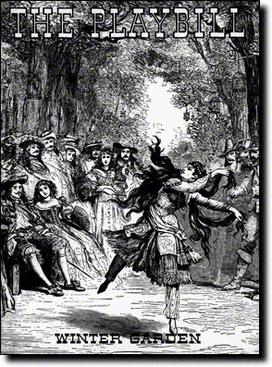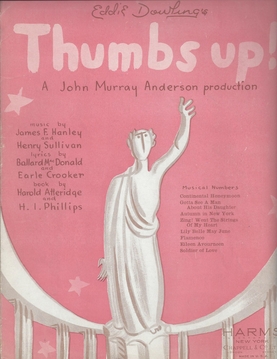Related Research Articles

Alfred Drake was an American actor and singer.
A revue is a type of multi-act popular theatrical entertainment that combines music, dance, and sketches. The revue has its roots in 19th century popular entertainment and melodrama but grew into a substantial cultural presence of its own during its golden years from 1916 to 1932. Though most famous for their visual spectacle, revues frequently satirized contemporary figures, news or literature. Similar to the related subforms of operetta and musical theatre, the revue art form brings together music, dance and sketches to create a compelling show. In contrast to these, however, revue does not have an overarching storyline. Rather, a general theme serves as the motto for a loosely related series of acts that alternate between solo performances and dance ensembles.

New Faces of 1952, also known as Leonard Sillman's New Faces of 1952, is a 1952 musical revue with songs and comedy skits, produced and conceived by Leonard Sillman. It was the fourth of Sillman's seven New Faces revues, each intended to showcase the rising stars of that time; the other years for which "New Faces of ..." revues were produced were 1934, 1936, 1943, 1956, 1962, and 1968. New Faces of 1952 was the most successful of the series, and is generally considered the best, for both the talent of the performers and the quality of the writing. The show ran on Broadway for nearly a year in 1952, and helped launch the careers of Paul Lynde, Alice Ghostley, Eartha Kitt, Robert Clary, Carol Lawrence, Ronny Graham, performer/writer Mel Brooks, and lyricist Sheldon Harnick.

Joan Diener was an American theatre actress and singer with a three-and-a-half-octave range. As her obituary in The New York Times summed it up, Diener's "lush beauty, showstopping stage presence and operatic voice made her a favorite in musicals, especially in the original 1965 Man of La Mancha."
Pins and Needles (1937) is a musical revue with a book by Arthur Arent, Marc Blitzstein, Emmanuel Eisenberg, Charles Friedman, David Gregory, Joseph Schrank, Arnold B. Horwitt, John Latouche, and Harold Rome, and music and lyrics by Rome. The title Pins and Needles was created by Max Danish, long-time editor of the International Ladies Garment Workers Union (ILGWU)'s newspaper Justice.

John Murray Anderson was a Canadian theatre director and producer, songwriter, actor, screenwriter, dancer and lighting designer, who made his career in the United States, primarily in New York City and Hollywood. He worked in almost every genre of show business, including vaudeville, Broadway, and film. He also directed plays in London.

As Thousands Cheer is a revue with a book by Moss Hart and music and lyrics by Irving Berlin, first performed in 1933. The revue contained satirical sketches and witty or poignant musical numbers, several of which became standards, including "Heat Wave", "Easter Parade" and "Harlem on my Mind". The sketches were loosely based on the news and the lives and affairs of the rich and famous, as well as other prominent personalities of the day, such as Joan Crawford, John D. Rockefeller Jr., Noël Coward, Josephine Baker, and Aimee Semple McPherson.

From A to Z is a musical revue with a book by Woody Allen, Herbert Farjeon, and Nina Warner Hook and songs by Jerry Herman, Fred Ebb, Mary Rodgers, Everett Sloane, Jay Thompson, Dickson Hughes, Jack Holmes, Paul Klein, Norman Martin, William Dyer, and Charles Zwar.

John Murray Anderson's Almanac is a musical revue, featuring the music of the songwriting team of Richard Adler and Jerry Ross, as well as other composers. It was conceived by John Murray Anderson. An earlier version of the show had been produced in 1929 with the title Murray Anderson's Almanac. The earlier production included Henry Sullivan for composing the music and Noël Coward as part of the script writing team. Sullivan would go on to write music for the 1953 production mentioned here. The full title for the show was John Murray Anderson's Almanac: A Musical Harlequinade.
Alive and Kicking is a musical revue with sketches by Ray Golden, I.A.L. Diamond, Henry Morgan, Jerome Chodorov, Joseph Stein, Will Glickman, John Murray, and Michael Stewart; music by Hal Borne, Irma Jurist, Sammy Fain, Hoagy Carmichael, Harold Rome, Sonny Burke, Leo Schumer, and Ray Golden; and lyrics by Paul Francis Webster, Ray Golden, Harold J. Rome, Leonard Gershe, Sid Kuller, and Michael Stewart.

Lend an Ear is a musical revue with a book, music, and lyrics by Charles Gaynor and additional sketches by Joseph Stein and Will Glickman.

Set to Music is a musical revue with sketches, music and lyrics by Noël Coward.

The Ziegfeld Follies of 1936 is a musical revue with lyrics by Ira Gershwin, music by Vernon Duke and sketches by Gershwin and David Freedman. The Ziegfeld Follies were a series of revues presented from 1907 through 1931, 1934, 1936, 1943, and 1957.
Life Begins at 8:40 is a musical revue with music by Harold Arlen, lyrics by Ira Gershwin and E.Y. Harburg, and sketches by Gershwin, Harburg, David Freedman, H.I. Phillips, Alan Baxter, Henry Clapp Smith, and Frank Gabrielson.

Parade is a musical revue with book, music, and lyrics by Jerry Herman.
White Horse Inn is the title of the Broadway version of the operetta Im weißen Rößl. The original operetta by Erik Charell and composers Ralph Benatzky and Robert Stolz was based on the popular farce of the same name by Oscar Blumenthal and Gustav Kadelburg. It was premiered at Berlin's Großes Schauspielhaus on 8 November 1930 and ran for 416 performances. The Broadway version was premiered on 1 October 1936 at the Center Theatre in New York City. It had a libretto by David Freedman and lyrics by Irving Caesar. The original score was re-orchestrated by Hans Spialek.

Thumbs Up! is a musical revue in two acts, with book by H. I. Phillips, Harold Atteridge, and Alan Baxter. The show had songs with lyrics by Ballard MacDonald and Earle Crooker and music by James F. Hanley and Henry Sullivan. Additional lyrics by Karl Stark, Ira Gershwin, John Murray Anderson, Irving Caesar, Jean Herbert, and Vernon Duke and additional music by Vernon Duke, Gerald Marks, and Steve Child. The show was produced by Eddie Dowling at the St. James Theatre. The revue opened on December 27, 1934.

Make Mine Manhattan is a 1948 Broadway revue with music by Richard Lewine, lyrics by Hassard Short, and sketches by Arnold Horwitt and produced by Joseph Hyman.

The Earl Carroll Vanities was a Broadway revue presented by Earl Carroll in the 1920s and early 1930s. Carroll and his show were sometimes controversial.

The Straw Hat Revue is a musical comedy revue with sketches mostly by Max Liebman and Samuel Locke, and music and lyrics by Sylvia Fine and James Shelton. It was produced on Broadway in 1939.
References
- ↑ Atkinson, Brooks. "Two for the Show Comes as the Successor to Last Year's One for the Money", The New York Times, February 9, 1940, p. 21.